System-Wide Seismic Risk Assessment of Port Facilities; Application to the Port of Thessaloniki, Greece
Abstract
:1. Introduction
2. Outline of the Proposed Methodology
3. The Port of Thessaloniki: Exposure and Soil Conditions
3.1. Port Facilities
3.2. Soil Conditions
4. Seismic Hazard Assessment
4.1. Probabilistic Seismic Hazard
4.2. Deterministic Scenario-Based Seismic Hazard
5. Fragility Models for Port Structures
6. Seismic Risk Assessment
6.1. Probabilistic Approach
6.1.1. Component Level Assessment
- Mean, median, 15%, and 85% quantile seismic hazard curves are estimated for each location across the port area. Hazard curves at the ground surface, also considering site effects, are assumed to be consistent with the corresponding fragility/vulnerability curves that use PGA at the surface as an intensity measure (IM);
- The computed seismic hazard curves (Figure 5b) are converted from probability of exceedance (PoEPGA) of PGA in 50 years (T) into annual rate of exceedance (λPGA) of PGA (Equation 3):
- The annual probability of occurrence of intensity level PGAi, P [PGAi], can be computed from the discrete points on the seismic hazard curve for the selected intensity measure (IM), i.e., PGA at ground surface. Assuming that the event under consideration is rare, the annual frequency is approximately equal to the annual probability of exceedance. The annual probability that the intensity level will fall within a bin of IM centered around IMi (i.e., P [IMi]) can be approximated from seismic hazard values using the following simplified expression [49]:where λi−1, λi, and λi+1 are adjacent hazard values centered around the intensity level PGAi. Provided that the bin size of IM is sufficiently small, the estimated probabilities of the IM using Equation 4 will approach the exact values;
- The probability of collapse conditioned on the central PGA value of each bin is then multiplied by the associated probability of occurrence for PGA values belonging to that bin, thus resulting in a distribution of probability of collapse for a set of ground motion intensities. By numerically integrating this distribution, the annual collapse probability (λc) is computed using the following expression:
- The annual probability (or frequency) of exceedance of different loss index (LI) levels conditioned on the PGAi is computed as follows:where the term , integrated over all bins for PGAi, is obtained from the given loss index curves derived by multiplying the corresponding damage index (see, for example, Figure 14) with an empirically derived reductive coefficient. For each specific level of LI, different median PGA and beta values are assigned for the given set of PGA intensities. By numerically integrating this distribution for all considered PGA intensities, the annual probability of exceeding the given loss level is computed;
- Mean, median, 15%, and 85% quantile loss exceedance curves are finally obtained for different levels of LI (%) for each port structure.
6.1.2. System Level Assessment
- Waterfront-piers (berth) are functional if Damage (D) is lower than moderate;
- Cranes are functional if Damage (D) is lower than moderate, the waterfront is functional, and there is electric power supply (either from the electric network or from the back-up supply);
- The berth is functional if the waterfront and at least one crane is functional, otherwise the functionality of the berth is zero (PIbi = 0) and the whole berth is set to non-functional;
- If the berth is functional, then PI is the sum of the crane capacities with respect to the functioning cranes that it includes. In case more than one crane is present, these can work simultaneously to download/upload containers from the same ship, reducing the time that the ship stays at each berth.
6.2. Deterministic Scenario-Based Approach
6.2.1. Component Level Assessment
6.2.2. System Level Assessment
7. Discussion-Conclusions
Author Contributions
Funding
Acknowledgments

Conflicts of Interest
References
- United Nations Conference on Trade and Development (UNCTAD). Review of Maritime Transport; United Nations Publication: New York, NY, USA, 2020; ISBN 9789211129939. [Google Scholar]
- Shinozuka, M. (Ed.) The Hanshin-Awaji Earthquake of January 17, 1995: Performance of Lifelines; Technical Report NCEER-95-0015; National Center for Earthquake Engineering Research (NCEER), State University of New York: Buffalo, NY, USA, 1995. [Google Scholar]
- Chang, S.E. Disasters and transport systems: Loss, recovery and competition at the Port of Kobe after the 1995 earthquake. J. Transp. Geogr. 2000, 8, 53–65. [Google Scholar] [CrossRef]
- Werner, S.D. Seismic Guidelines for Ports; Monograph No. 12; American Society of Civil Engineers (ASCE): Reston, VA, USA, 1998; Chapter 2. [Google Scholar]
- Bernal, A.; Blazquez, R.; Burcharth, H.F.; Dickenson, S.; Ferritto, J.; Finn, L.; Iai, S.; Ichii, K.; McCullough, N.J.; Meeuwissen, P.W.H.; et al. Seismic Design Guidelines for Port Structures; Balkema: Rotterdam, The Netherlands, 2001; 474p. [Google Scholar]
- Stewart, J.P.; Fenves, G.L.; Seed, R.B. Seismic soil-structure-interaction in buildings I: Analytical methods. ASCE J. Geotech. Geoenviron. Eng. 1999, 125, 26–37. [Google Scholar] [CrossRef]
- Pachakis, D.; Kiremidjian, A.S. Estimation of Downtime—Related Revenue Losses in Maritime Ports due to Earthquakes; Technical Report No. 146; John A. Blume Earthquake Engineering Center: Stanford, CA, USA, 2005. [Google Scholar]
- Pitilakis, K.; Franchin, P.; Khazai, B.; Wenzel, H. (Eds.) SYNER-G: Systemic Seismic Vulnerability and Risk Assessment of Complex Urban, Utility, Lifeline Systems and Critical Facilities. Methodology and Applications; Geotechnical, Geological and Earthquake Engineering Series; Springer: Dordrecht, The Netherlands, 2014; Volume 31. [Google Scholar]
- Pitilakis, K.; Argyroudis, S.; Fotopoulou, S.; Karafagka, S.; Kakderi, K.; Selva, J. Application of stress test concepts for port infrastructures against natural hazards. The case of Thessaloniki port in Greece. Reliab. Eng. Syst. Saf. 2019, 184, 240–257. [Google Scholar] [CrossRef]
- Werner, S.; Taylor, C. Final Report: Seismic Risk Reduction Planning Evaluations for Wharf and Embankment Strengthening Program (WESP); Prepared by SEISEC-NHMI for Port of Oakland, Oakland, CA; Port of Oakland: Oakland, CA, USA, 2004. [Google Scholar]
- Conca, D.; Bozzoni, F.; Carlo, G.L. Interdependencies in Seismic Risk Assessment of Seaport Systems: Case Study at Largest Commercial Port in Italy. ASCE-ASME J. Risk Uncertain. Eng. Syst. Part A Civ. Eng. 2020, 6, 4020006. [Google Scholar] [CrossRef]
- Pitilakis, K.; Argyroudis, S.; Fotopoulou, S.; Karafagka, S.; Anastasiadis, A.; Pitilakis, D.; Raptakis, D.; Riga, E.; Tsinaris, A.; Mara, K.; et al. Deliverable D6.1: Integrated Report Detailing Analyses, Results and Proposed Hierarchical set of Stress Tests for the six CIs. STREST EC/FP7 Project: Harmonized Approach to Stress Tests for Critical Infrastructures Against Natural Hazards; ETH Zürich: Zürich, Switzerland, 2016; Available online: www.strest-eu.org (accessed on 1 September 2016).
- Kakderi, K.; Selva, J.; Argyroudis, S.; Pitilakis, K.; Anastasiadis, A.; Alexoudi, M.; Souli, A.; Fotopoulou, S.; Rovithis, M.; Senetakis, K. Application and Validation Study to a Harbor System (Thessaloniki, Greece). Deliverable 6.6, SYNER-G Project; Aristotle University of Thessaloniki: Thessaloniki, Greece, 2013. [Google Scholar]
- Crowley, H.; Casotto, C.; Pitilakis, K.; Kakderi, K.; Argyroudis, S.; Fotopoulou, S.; Lanzano, G.; Salzano, E.; Iervolino, I.; Basco, A.; et al. Deliverable D4.4: Report on the Taxonomy of Cis Based on Their Vulnerability Characteristics and Exposure to Natural Hazard Initiating Events. STREST Project: Harmonized Approach to Stress Tests for Critical Infrastructures against Natural Hazards; ETH Zürich: Zürich, Switzerland, 2016. [Google Scholar]
- Anastasiadis, A.; Raptakis, D.; Pitilakis, K. Thessaloniki’s detailed microzoning: Subsurface structure as basis for site response analysis. Pure Appl. Geophys. 2001, 158, 2597–2633. [Google Scholar] [CrossRef]
- Apostolidis, P.; Raptakis, D.; Roumelioti, Z.; Pitilakis, K. Determination of S-wave velocity structure using microtremors and spac method applied in Thessaloniki (Greece). Soil Dyn. Earthq. Eng. 2001, 24, 49–67. [Google Scholar] [CrossRef]
- Pagani, M.; Monelli, D.; Weatherill, G.; Danciu, L.; Crowley, H.; Silva, V.; Henshaw, P.; Butler, L.; Nastasi, M.; Panzeri, L.; et al. OpenQuake-engine: An Open Hazard (and Risk) Software for the Global Earthquake Model. Seismol. Res. Lett. 2014, 85, 692–702. [Google Scholar] [CrossRef] [Green Version]
- Woessner, J.; Danciu, L.; Giardini, D.; Crowley, H.; Cotton, F.; Grünthal, G.; Valensise, G.; Arvidsson, R.; Basili, R.; Demircioglu, M.B.; et al. The 2013 European Seismic Hazard Model: Key Components and Results. Bull. Earthq. Eng. 2015, 13, 3553–3596. [Google Scholar] [CrossRef] [Green Version]
- Akkar, S.; Bommer, J.J. Empirical equations for the prediction of PGA, PGV, and spectral accelerations in Europe, the Mediterranean region, and the Middle East. Seismol. Res. Lett. 2010, 81, 195–206. [Google Scholar] [CrossRef] [Green Version]
- Cauzzi, C.; Faccioli, E. Broadband (0.05 to 20 s) prediction of displacement response spectra based on worldwide digital records. J. Seismol. 2008, 12, 453–475. [Google Scholar] [CrossRef]
- Chiou, B.S.J.; Youngs, R.R. An NGA model for the average horizontal component of peak ground motion and response spectra. Earthq. Spectra 2008, 24, 173–215. [Google Scholar] [CrossRef] [Green Version]
- Zhao, J.X.; Zhang, J.; Asano, A.; Ohno, Y.; Oouchi, T.; Takahashi, T.; Ogawa, H.; Irikura, K.; Thio, H.K.; Somerville, P.G.; et al. Attenuation relations of strong ground motion in Japan using site classification based on predominant period. Bull. Seismol. Soc. Am. 2006, 96, 898–913. [Google Scholar] [CrossRef]
- Youd, T.L.; Idriss, I.M.; Andrus, R.D.; Arango, I.I.; Castro, G.; Christian, J.T.; Dobry, R.; Finn, W.D.L.; Harder, L.F., Jr.; Hynes, M.E.; et al. Liquefaction resistance of soils: Summary report from the 1996 NCEER and 1998 NCEER/NSF workshops on evaluation of liquefaction resistance of soils. J. Geotech. Geoenviron. Eng. 2001, 127, 817–903. [Google Scholar] [CrossRef] [Green Version]
- Papaioannou, C. Deliverable D3.B: Seismic Hazard Scenarios—Probabilistic Seismic Hazard Analysis, SRM-Life Project: Development of a Global Methodology for the Vulnerability Assessment and Risk Management of Lifelines, Infrastructures and Critical Facilities. Application to the Metropolitan Area of Thessaloniki (in Greek); AUTH Research Committee: Thessaloniki, Greece, 2004. [Google Scholar]
- Caputo, R.; Pavlides, S. The Greek Database of Seismogenic Sources (GreDaSS), Version 2.0.0: A Compilation of Potential Seismogenic Sources (Mw > 5.5) in the Aegean Region, 2013. Available online: https://gredass.unife.it/ (accessed on 1 July 2013).
- Caputo, R.; Chatzipetros, A.; Pavlides, S.; Sboras, S. The Greek Database of Seismogenic Sources (GreDaSS): State-of-the-art for northern Greece. Ann. Geophys. 2012, 55, 859–894. [Google Scholar]
- Akkar, S.; Sandıkkaya, M.A.; Bommer, J.J. Empirical ground-motion models for point- and extended source crustal earthquake scenarios in Europe and the Middle East. Bull. Earthq. Eng. 2014, 12, 359–387. [Google Scholar] [CrossRef] [Green Version]
- Giardini, D.; Woessner, J.; Danciu, L.; Crowley, H.; Cotton, F.; Grünthal, G.; Pinho, R.; Valensise, G.; Akkar, S.; Arvidsson, R.; et al. Seismic Hazard Harmonization in Europe (SHARE). Online Data Resource. 2013. Available online: http://www.share-eu.org/ (accessed on 25 November 2013).
- Pitilakis, K.; Riga, Ε.; Anastasiadis, A. New code site classification, amplification factors and normalized response spectra based on a worldwide ground-motion database. Bull. Earthq. Eng. 2013, 11, 925–966. [Google Scholar] [CrossRef]
- Baker, J.W.; Cornell, C.A. A vector valued ground motion intensity measure consisting of spectral acceleration and epsilon. Earthq. Eng. Struct. Dyn. 2005, 34, 1193–1217. [Google Scholar] [CrossRef]
- Iervolino, I.; Galasso, C.; Cosenza, E. REXEL: Computer aided record selection for code-based seismic structural analysis. Bull. Earthq. Eng. 2010, 8, 339–362. [Google Scholar] [CrossRef]
- Elgamal, A.; Yang, Z.; Lu, J. Cyclic1D Seismic Ground Response Version 1.4, User’s Manual; Department of Structural Engineering, University of California: San Diego, CA, USA, 2015. [Google Scholar]
- Chan, A.H.C. A Unified Finite Element Solution to Static and Dynamic Problems in Geomechanics. Ph.D. Dissertation, University College of Swansea, Swansea, UK, 1988. [Google Scholar]
- Parra, E. Numerical Modeling of Liquefaction and Lateral Ground Deformation Including Cyclic Mobility and Dilative Behavior is Soil Systems. PhD Dissertation, Department of Civil Engineering, Rensselaer Polytechnic Institute, Troy, NY, USA, 1996. [Google Scholar]
- Yang, Z. Numerical Modeling of Earthquake Site Response Including Dilation and Liquefaction. Ph.D. Dissertation, Department of Civil Engineering and Engineering Mechanics, Columbia University, New York, NY, USA, 2000. [Google Scholar]
- Prevost, J.H.A. Simple Plasticity Theory for Frictional Cohesionless Soils. Soil Dyn. Earthq. Eng. 1985, 4, 9–17. [Google Scholar] [CrossRef]
- Robertson, P.K.; Wride, C.E. Evaluating cyclic liquefaction potential using the cone penetration test. Can. Geotech. J. 1998, 35, 442–459. [Google Scholar] [CrossRef]
- Seed, R.B.; Cetin, K.O.; Moss, R.E.S.; Kammerer, A.; Wu, J.; Pestana, J.; Riemer, M.; Sancio, R.B.; Bray, J.D.; Kayen, R.E.; et al. Recent advances in soil liquefaction engineering: A unified and consistent framework; Keynote Presentation. In Proceedings of the 26th Annual ASCE Los Angeles Geotechnical Spring Seminar, Long Beach, CA, USA, 30 April 2003. [Google Scholar]
- Youd, T.L.; Idriss, I.M. (Eds.) NCEER 97. Proceedings of the NCEER Workshop on Evaluation of Liquefaction Resistance; Technical Report NCEER-97-0022; National Center for Earthquake Engineering Research (NCEER); State University of New York: Buffalo, NY, USA, 1997. [Google Scholar]
- European Committee for Standardization. EN 1998-5. Eurocode 8: Design of structures for earthquake resistance—Part 5: Foundations, Retaining Structures and Geotechnical Aspects; European Committee for Standardization: Brussels, Belgium, 2004. [Google Scholar]
- National Institute of Building Sciences, NIBS. Direct Physical Damage—General Building Stock. HAZUS-MH Technical Manual; Federal Emergency Management Agency: Washington, DC, USA, 2004; Chapter 5. [Google Scholar]
- Pitilakis, K.; Crowley, H.; Kaynia, A. SYNER-G: Typology Definition and Fragility Functions for Physical Elements at Seismic Risk. Buildings, Lifelines, Transportation Networks and Critical Facilities; Geotechnical, Geological and Earthquake Engineering Series; Springer: Dordrecht, The Netherlands, 2014; Volume 27. [Google Scholar]
- Laboratory of Soil Mechanics, Foundation and Geotechnical Earthquake Engineering of AUTH; National Technical University of Athens (NTUA). UPGRADE Research Project. Deliverable D8.2 Technical Reports with the Calculation Results of the Vulnerability of Specific Greek Port Facilities (in Greek). Contemporary Evaluation Methodology of Seismic Vulnerability and Upgrade of Port Facilities; NTUA Research Committee: Athens, Greece, 2015. [Google Scholar]
- Kappos, A.J.; Panagiotopoulos, C.; Panagopoulos, G.; Panagopoulos, E. WP4—Reinforced Concrete Buildings (Level I and II Analysis), RISK-UE: An Advanced Approach to Earthquake Risk Scenarios with Applications to Different European Towns; European Commission: Brussels, Belgium, 2003. [Google Scholar]
- Kappos, A.J.; Panagopoulos, G.; Panagiotopoulos, C.; Penelis, G. A hybrid method for the vulnerability assessment of R/C and URM buildings. Bull. Earthq. Eng. 2006, 4, 391–419. [Google Scholar] [CrossRef]
- Karafagka, S.; Fotopoulou, S.; Karatzetzou, A.; Malliotakis, G.; Pitilakis, D. The effect of soil-structure interaction and liquefaction on the seismic vulnerability of typical port steel light-frame warehouses. In Proceedings of the 8th ECCOMAS Thematic Conference on Computational Methods in Structural Dynamics and Earthquake Engineering, COMPDYN 2021, Streamed from Athens, Greece, 27–30 June 2021. [Google Scholar]
- Karafagka, S.; Fotopoulou, S.; Pitilakis, D. Fragility curves of non-ductile RC frame buildings on soft soils including liquefaction effects and soil-structure interaction. Bull. Earthq. Eng. 2021, 19, 6443–6468. [Google Scholar] [CrossRef]
- Fotopoulou, S.; Pitilakis, K. Vulnerability assessment of reinforced concrete buildings at precarious slopes subjected to combined ground shaking and earthquake induced landslide. Soil Dyn. Earthq. Eng. 2017, 93, 84–98. [Google Scholar] [CrossRef]
- Fotopoulou, S.; Pitilakis, K. Probabilistic assessment of the vulnerability of reinforced concrete buildings subjected to earthquake induced landslides. Bull. Earthq. Eng. 2017, 15, 5191–5215. [Google Scholar] [CrossRef]
- Lam, J.S.L.; Lassa, J.A. Risk assessment framework for exposure of cargo and ports to natural hazards and climate extremes. Marit. Policy Manag. 2017, 44, 1–15. [Google Scholar] [CrossRef]
- Kongar, I.; Giovinazzi, S.; Rossetto, T. Seismic performance of buried electrical cables: Evidence-based repair rates and fragility functions. Bull. Earthq. Eng. 2017, 15, 3151–3181. [Google Scholar] [CrossRef] [Green Version]
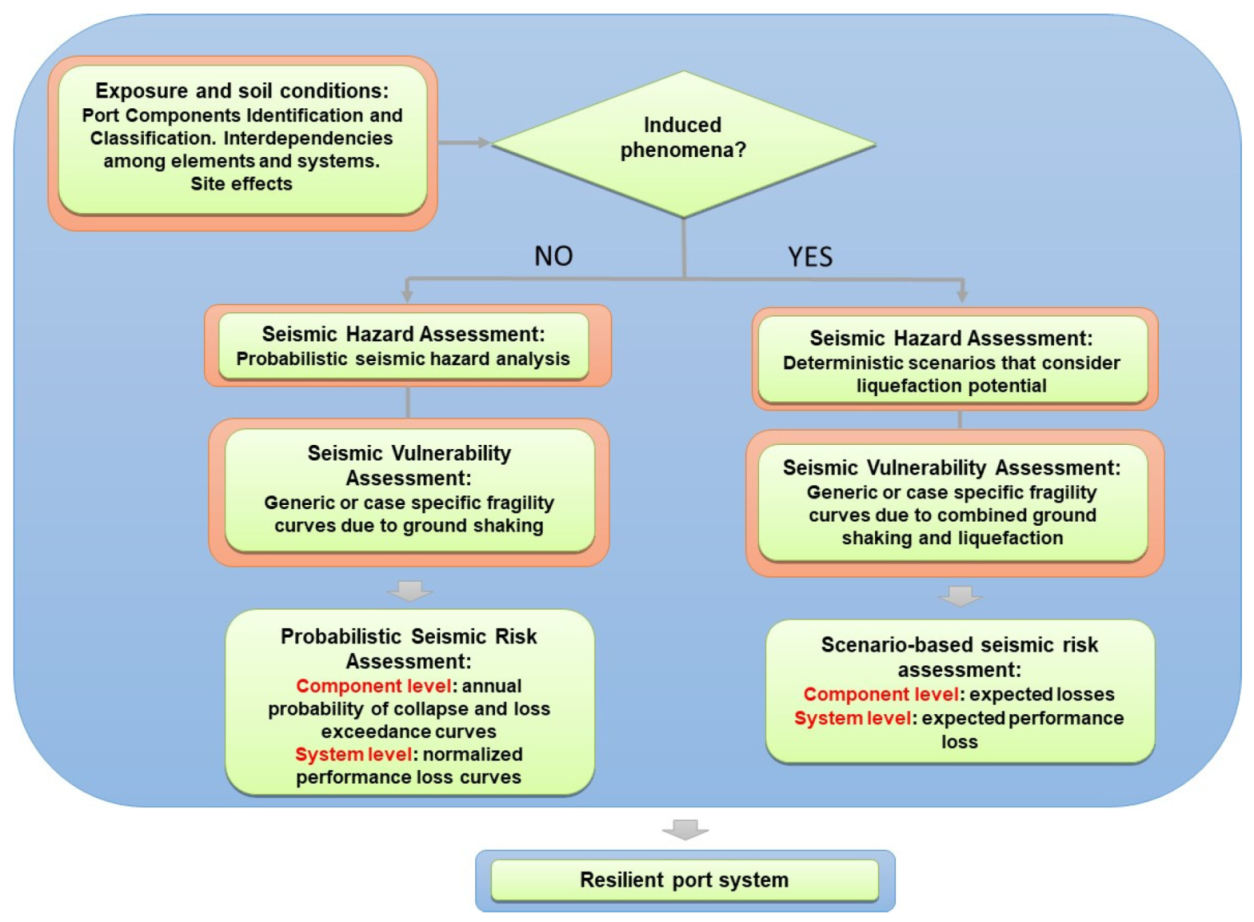
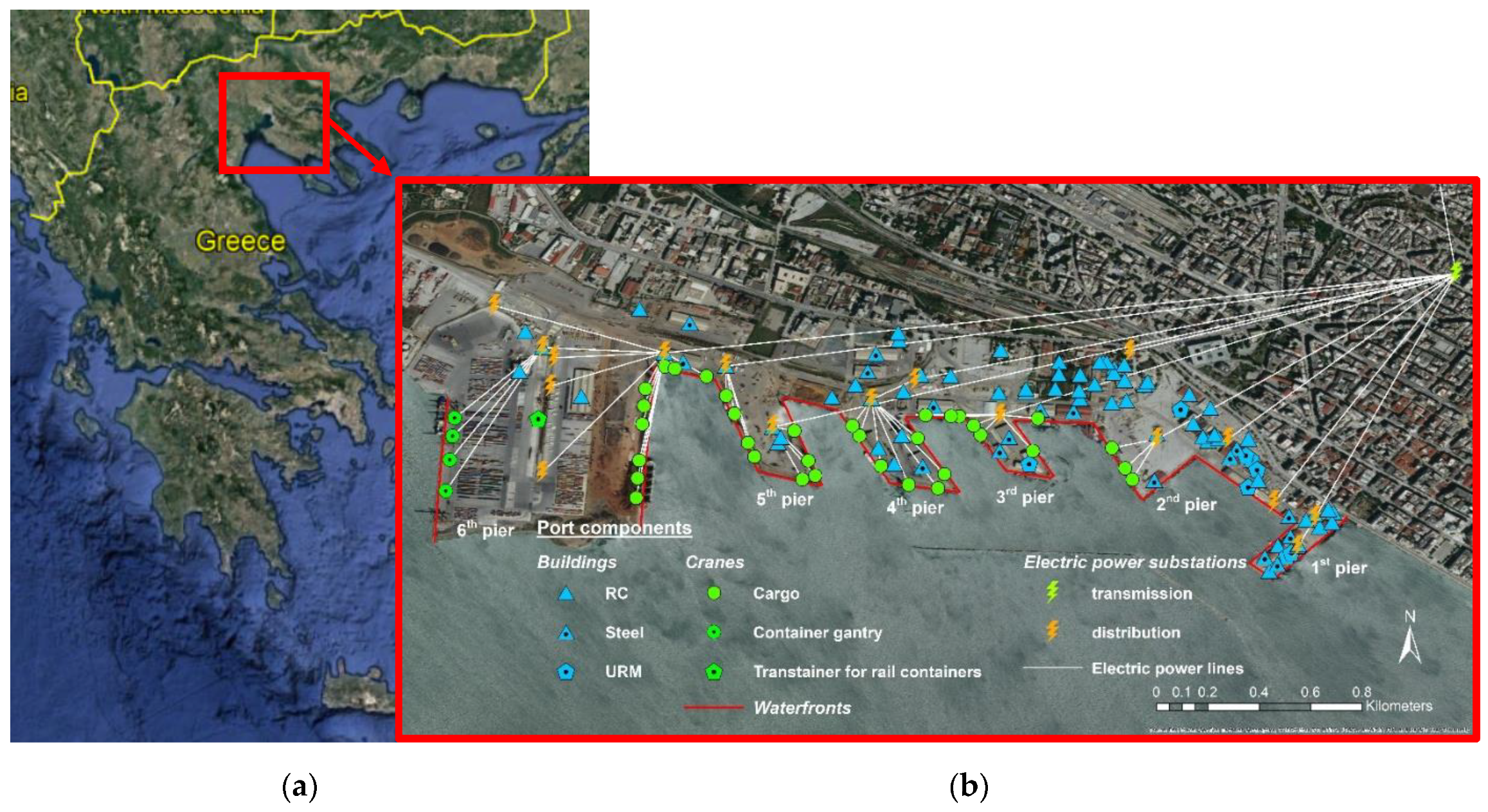

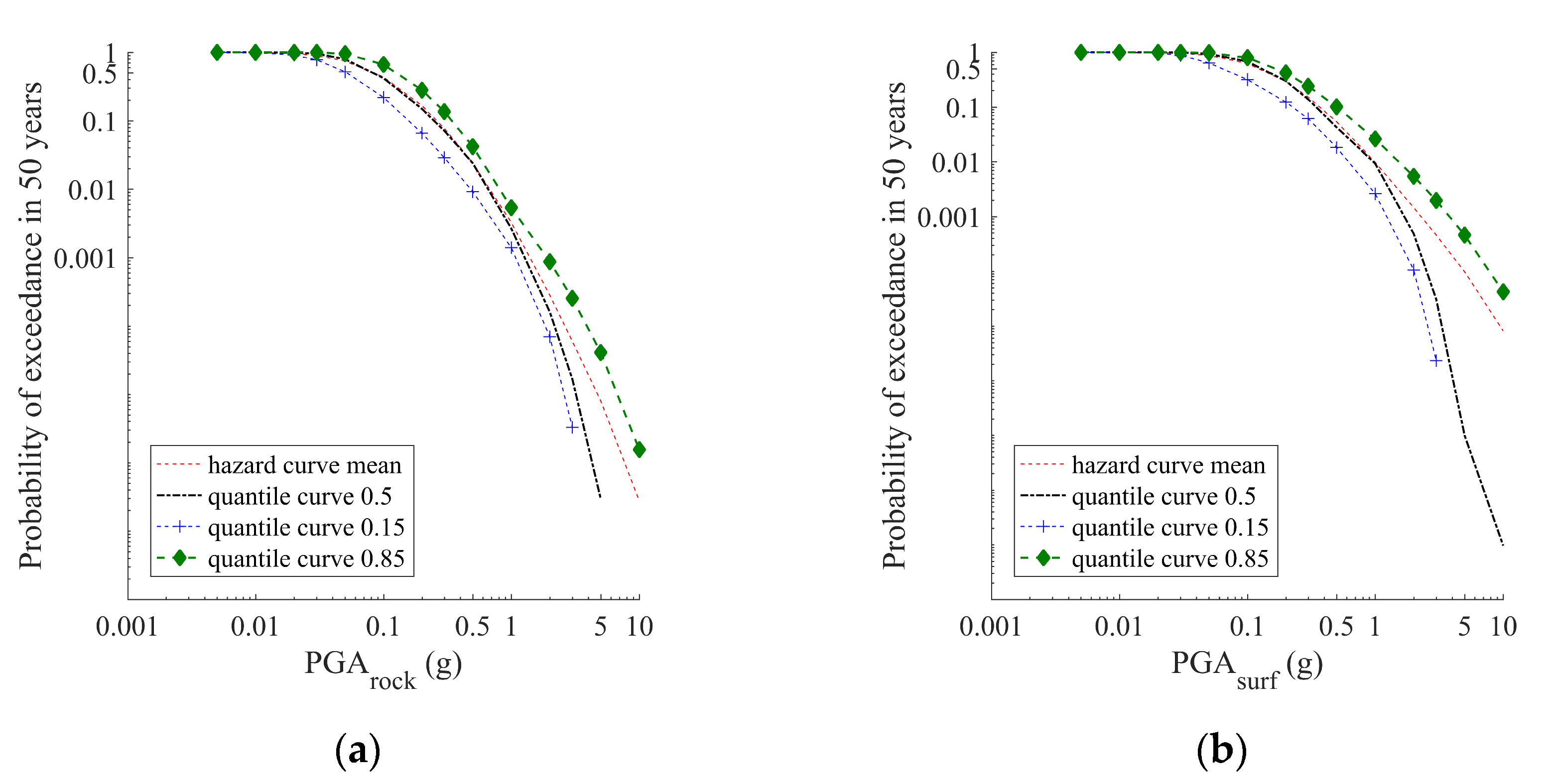
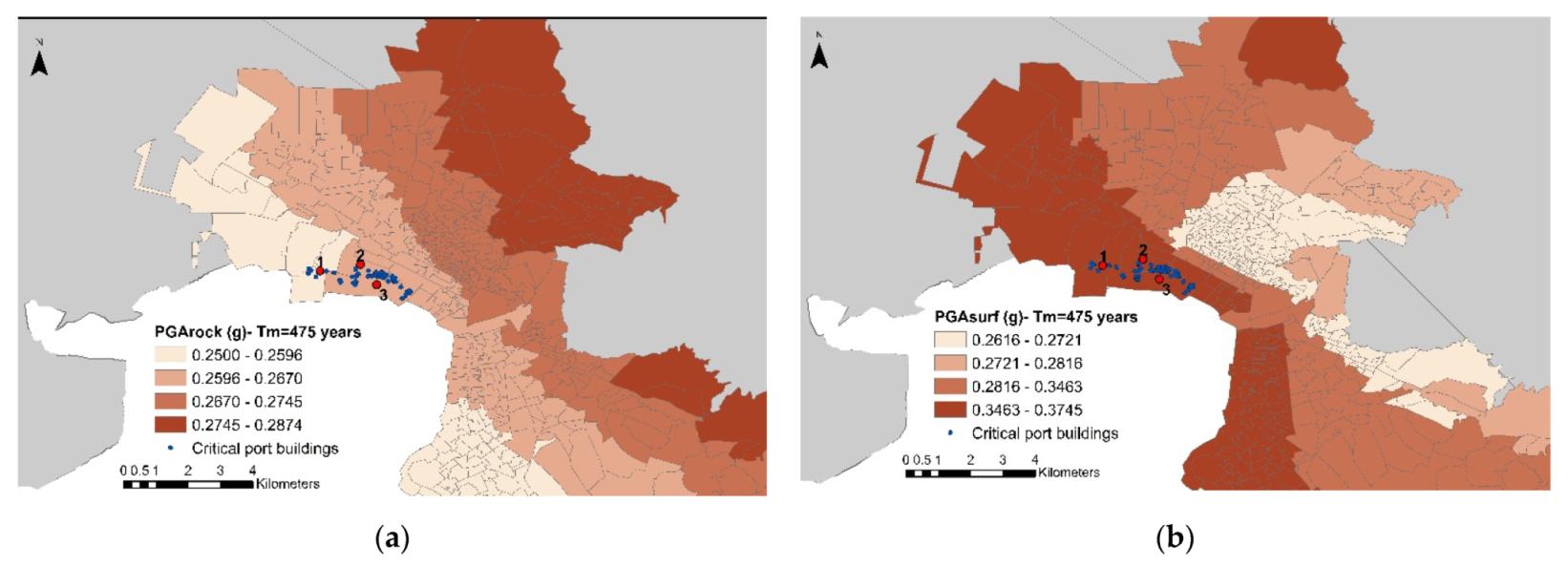
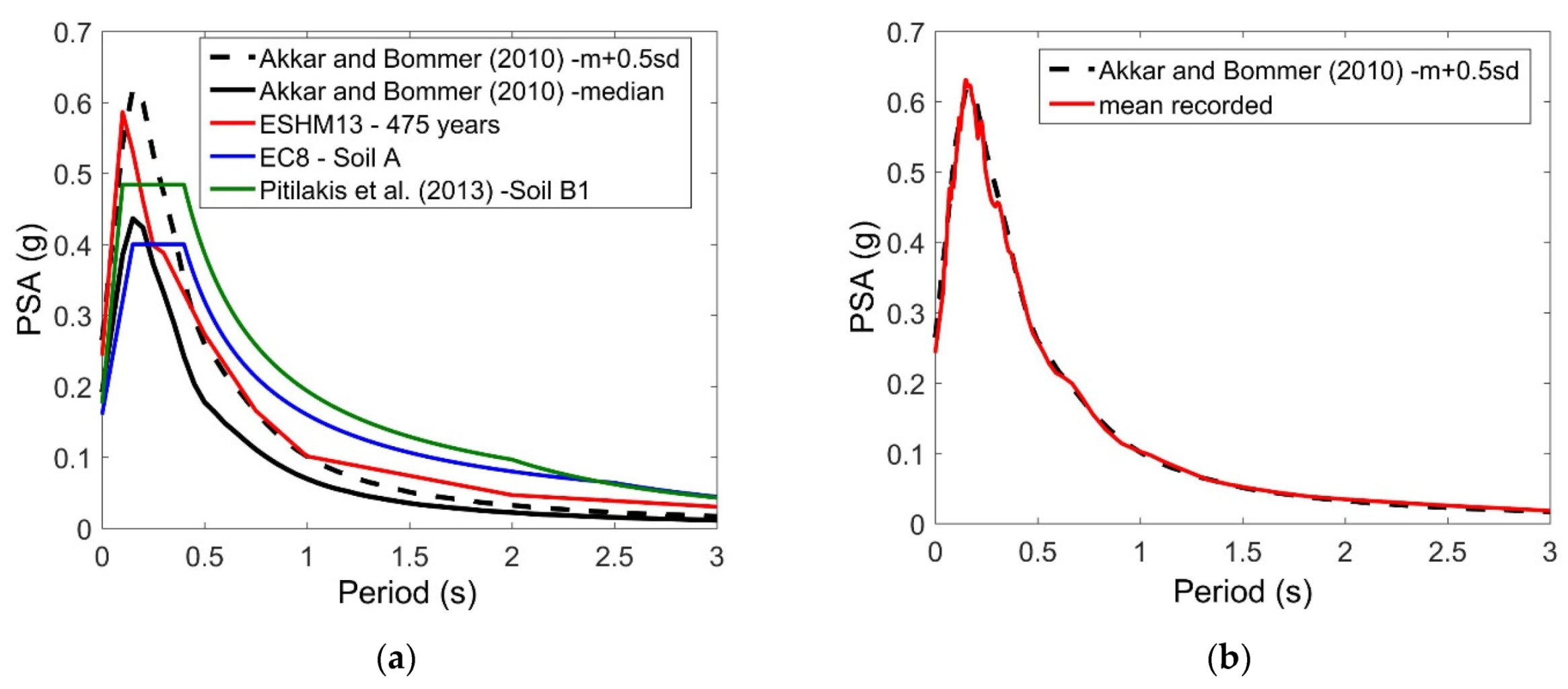

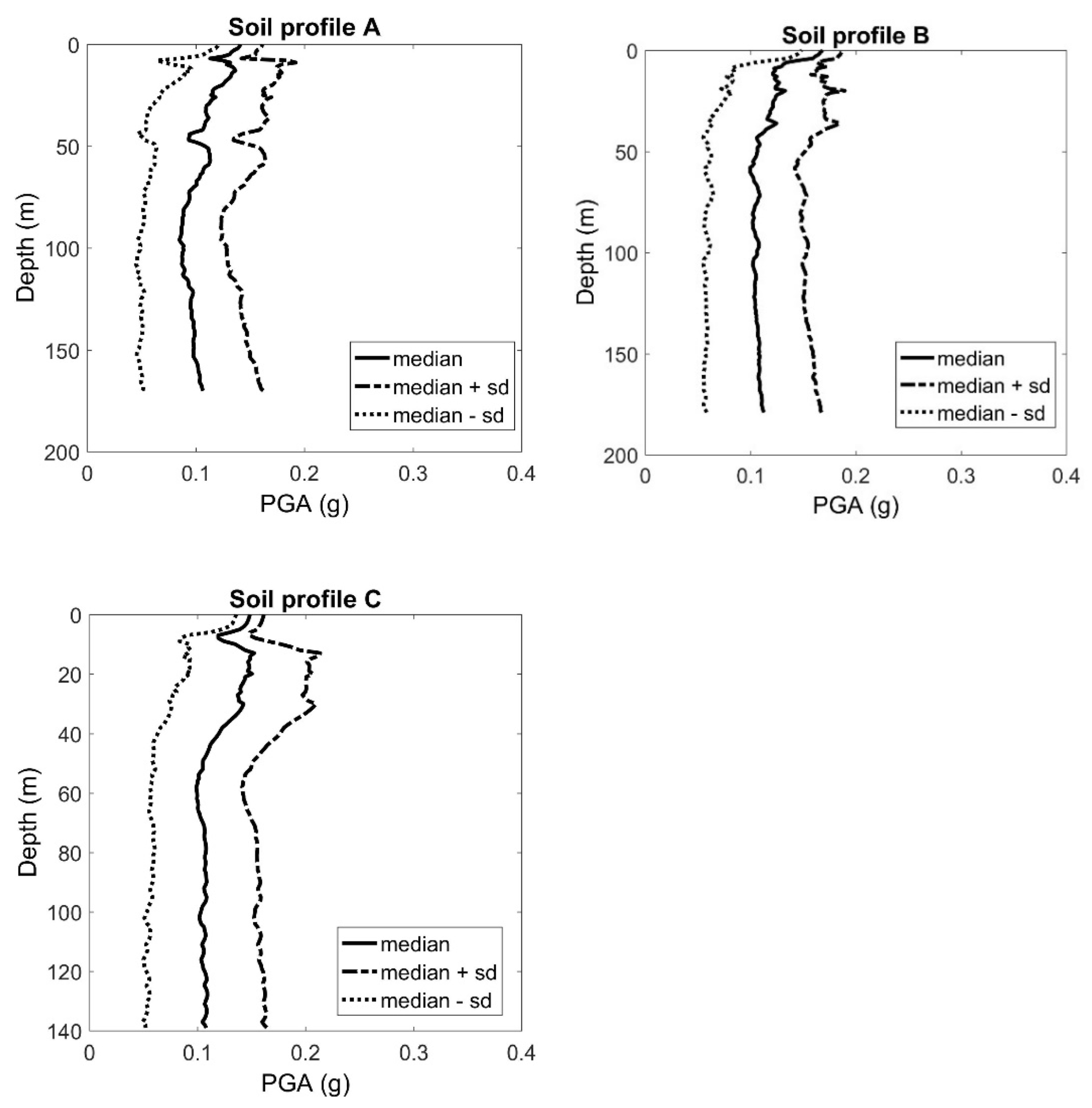
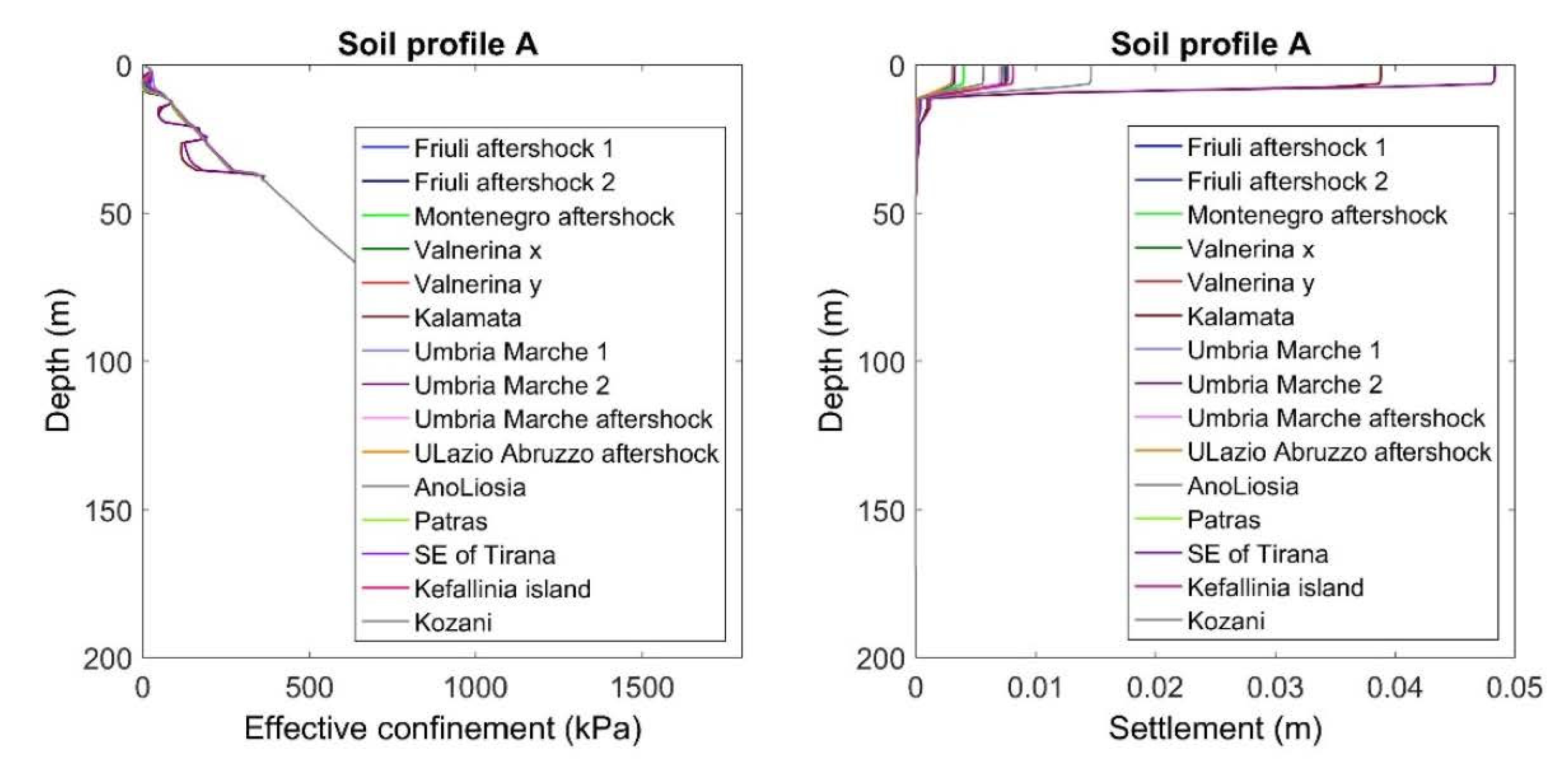
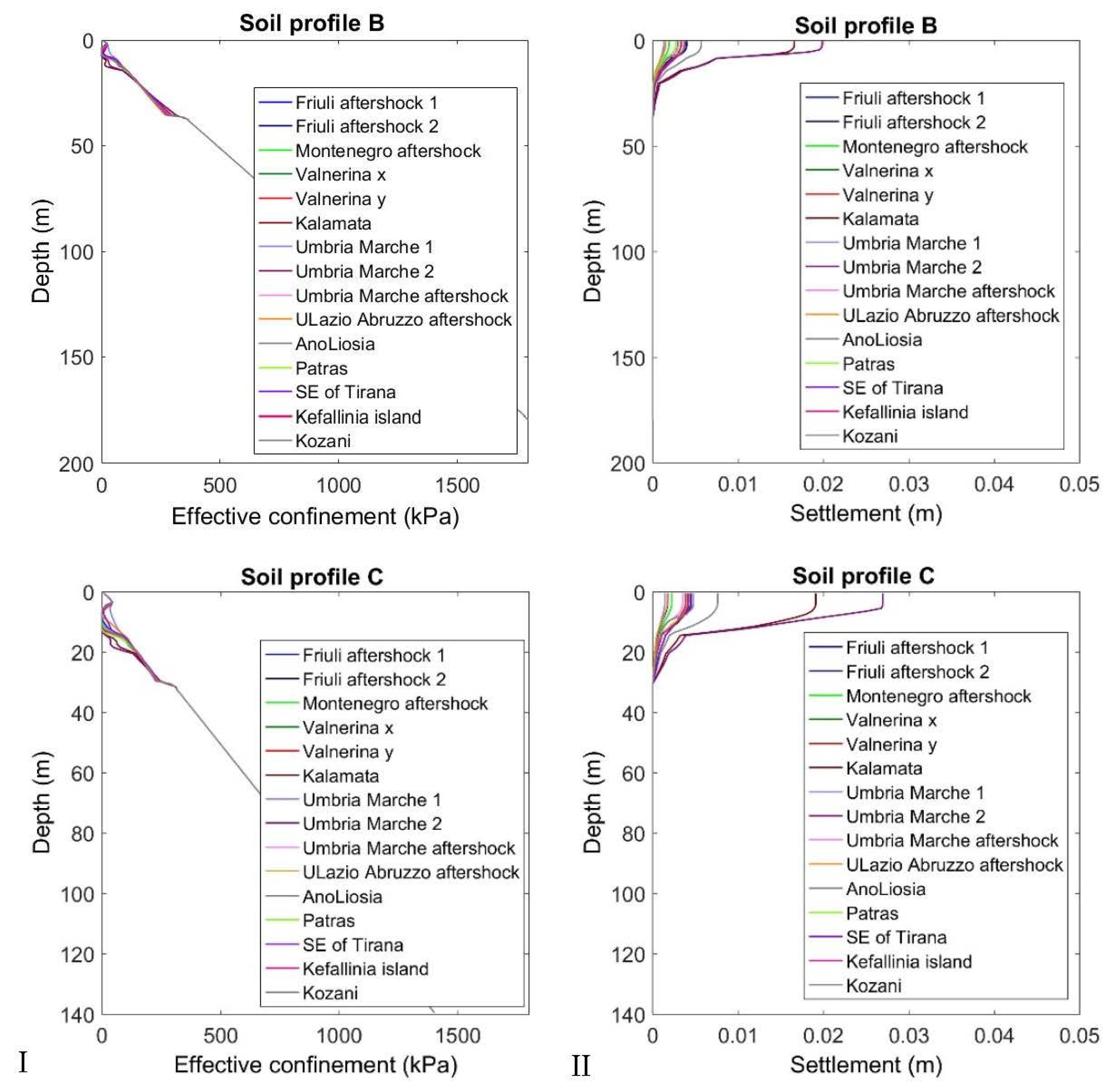
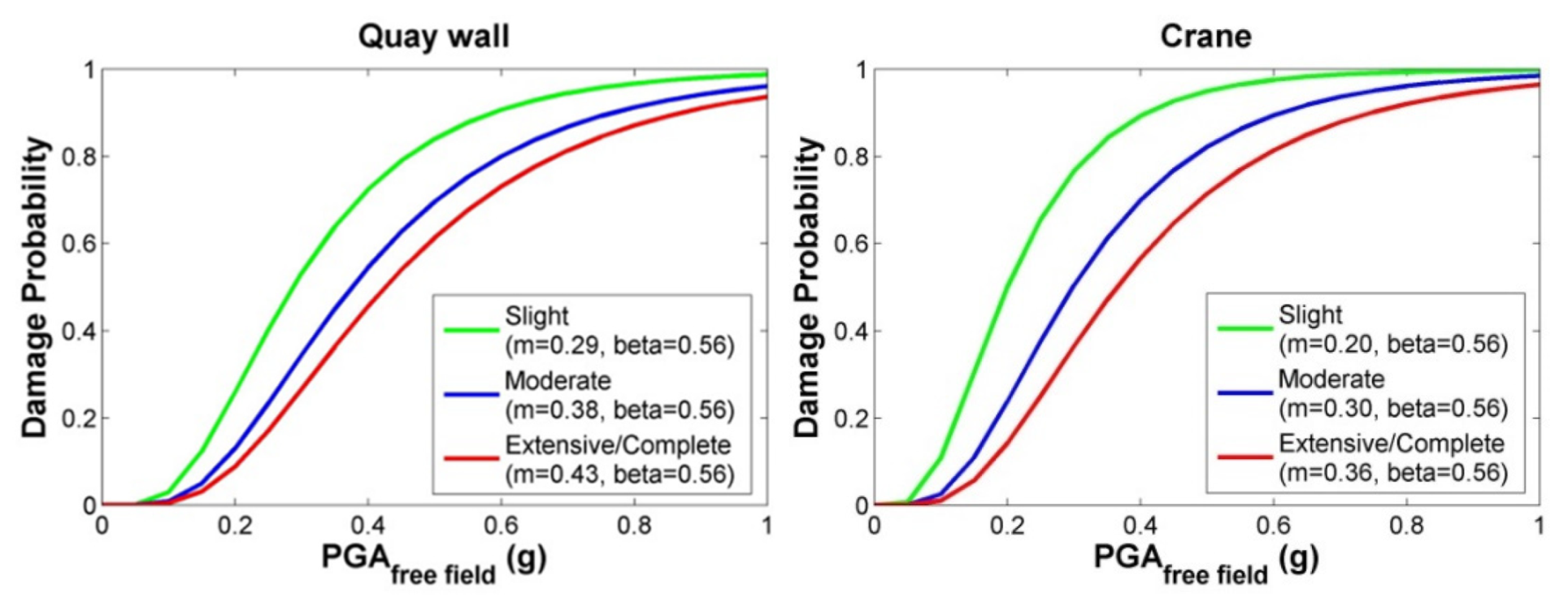
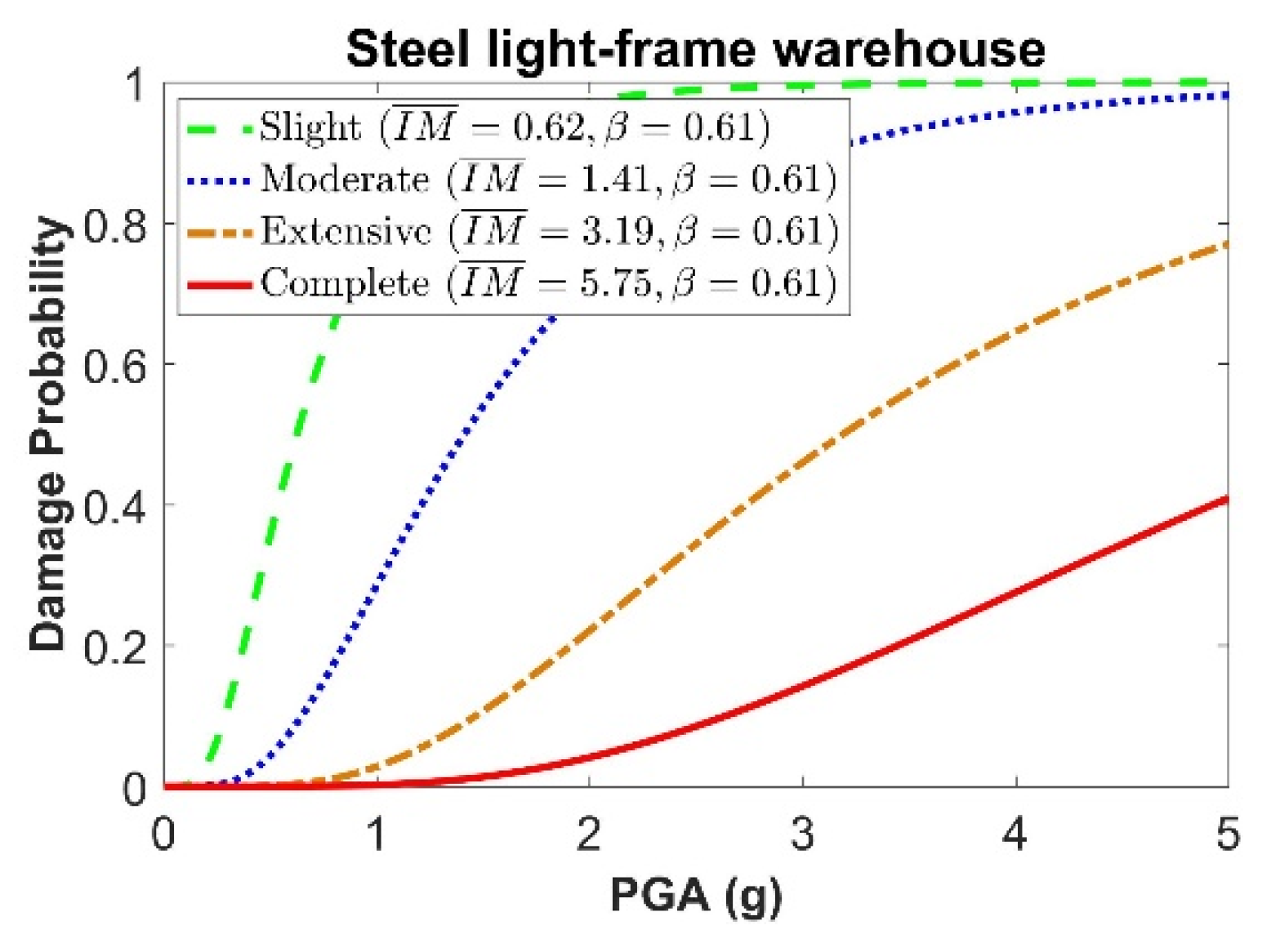


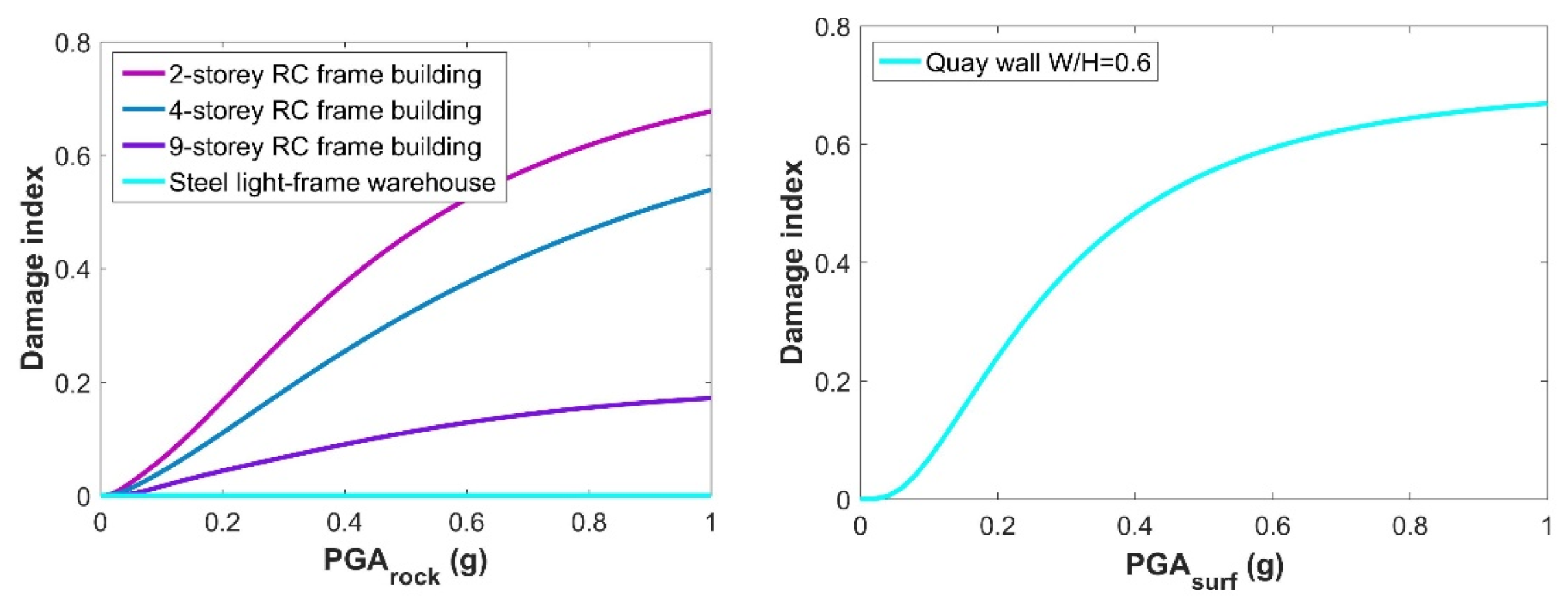
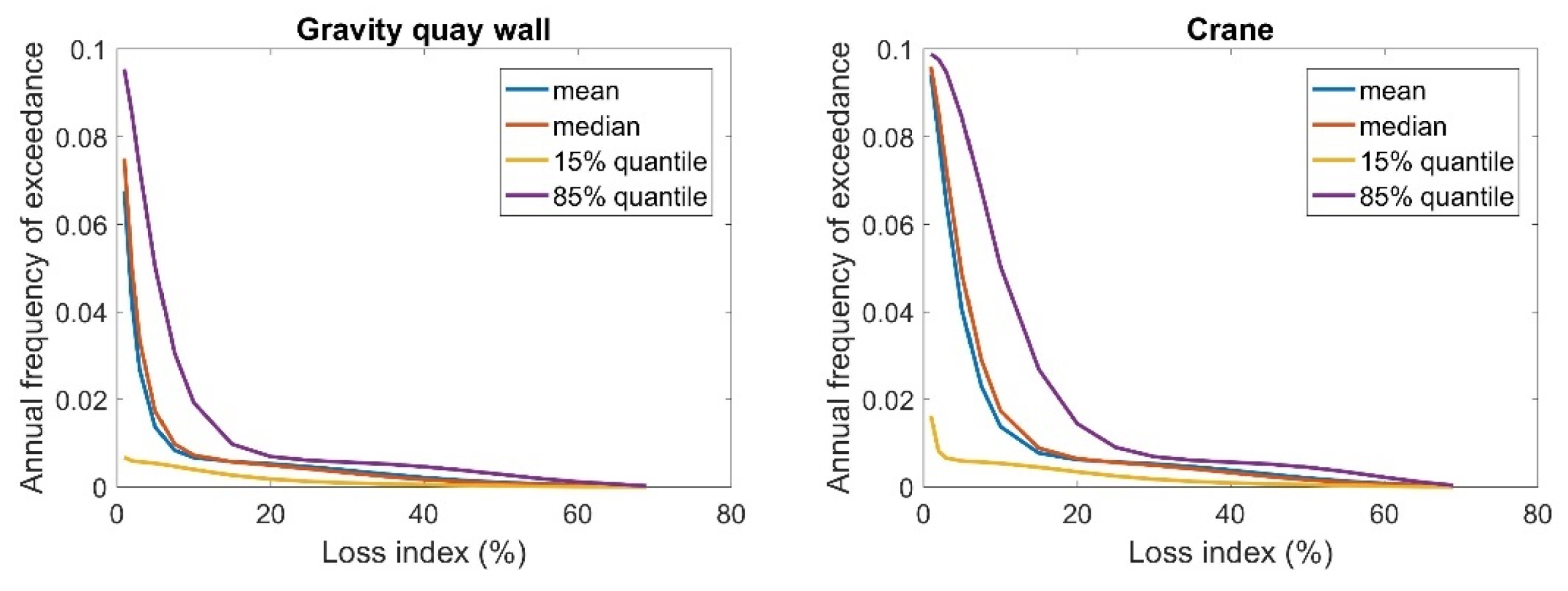
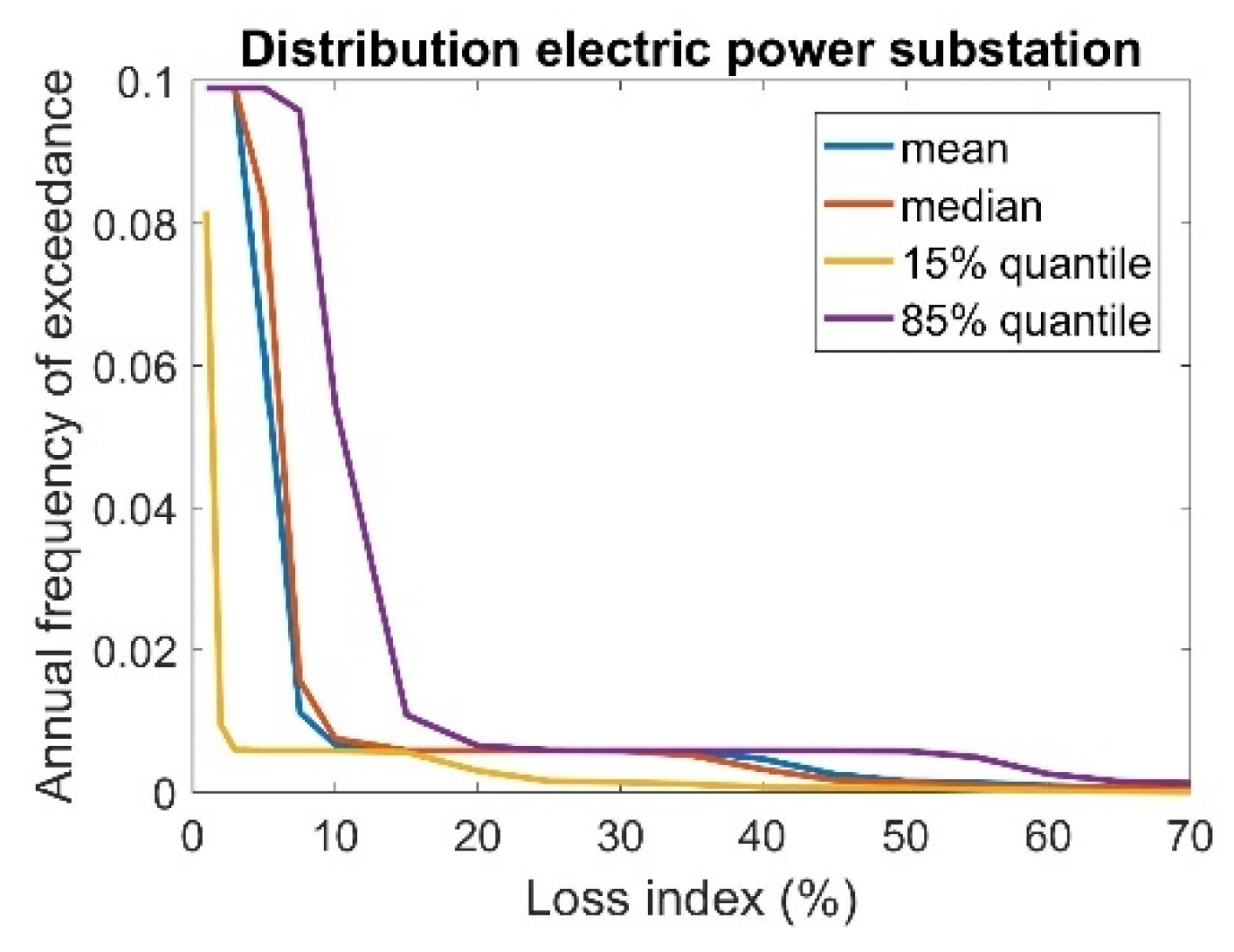
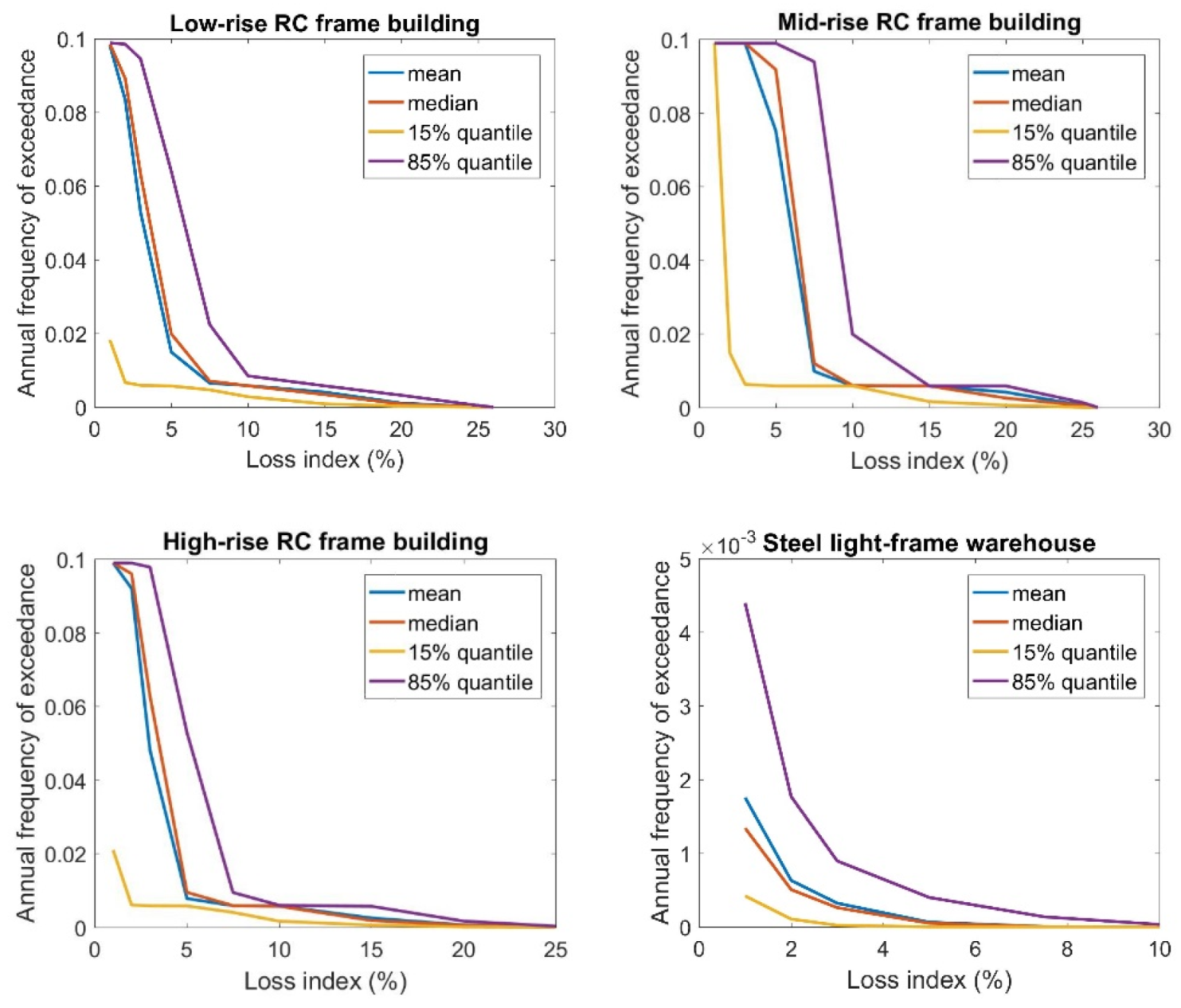
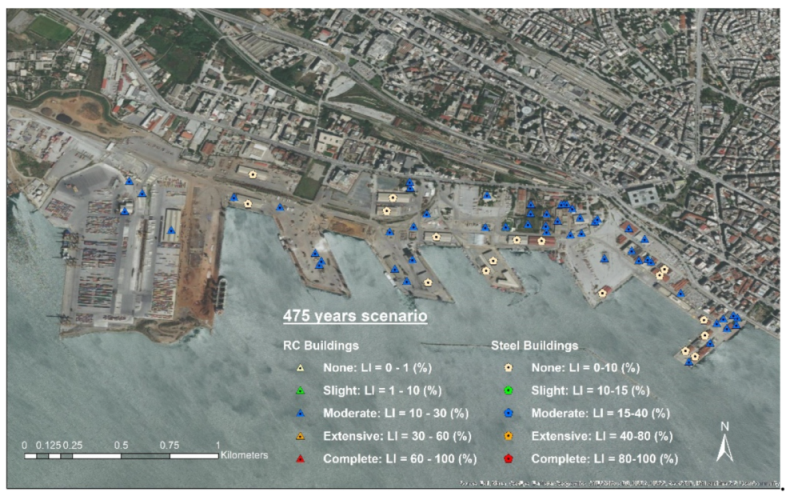
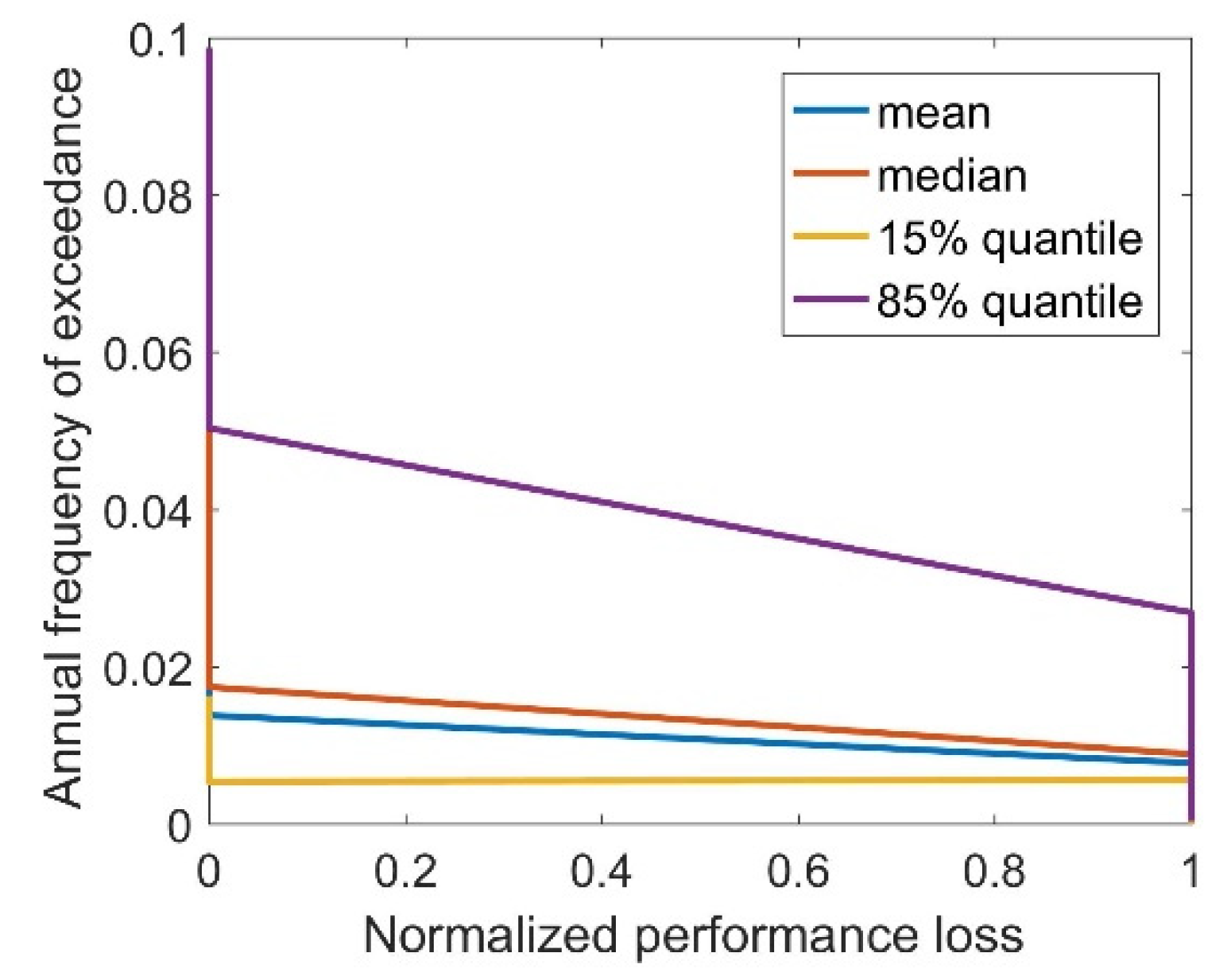
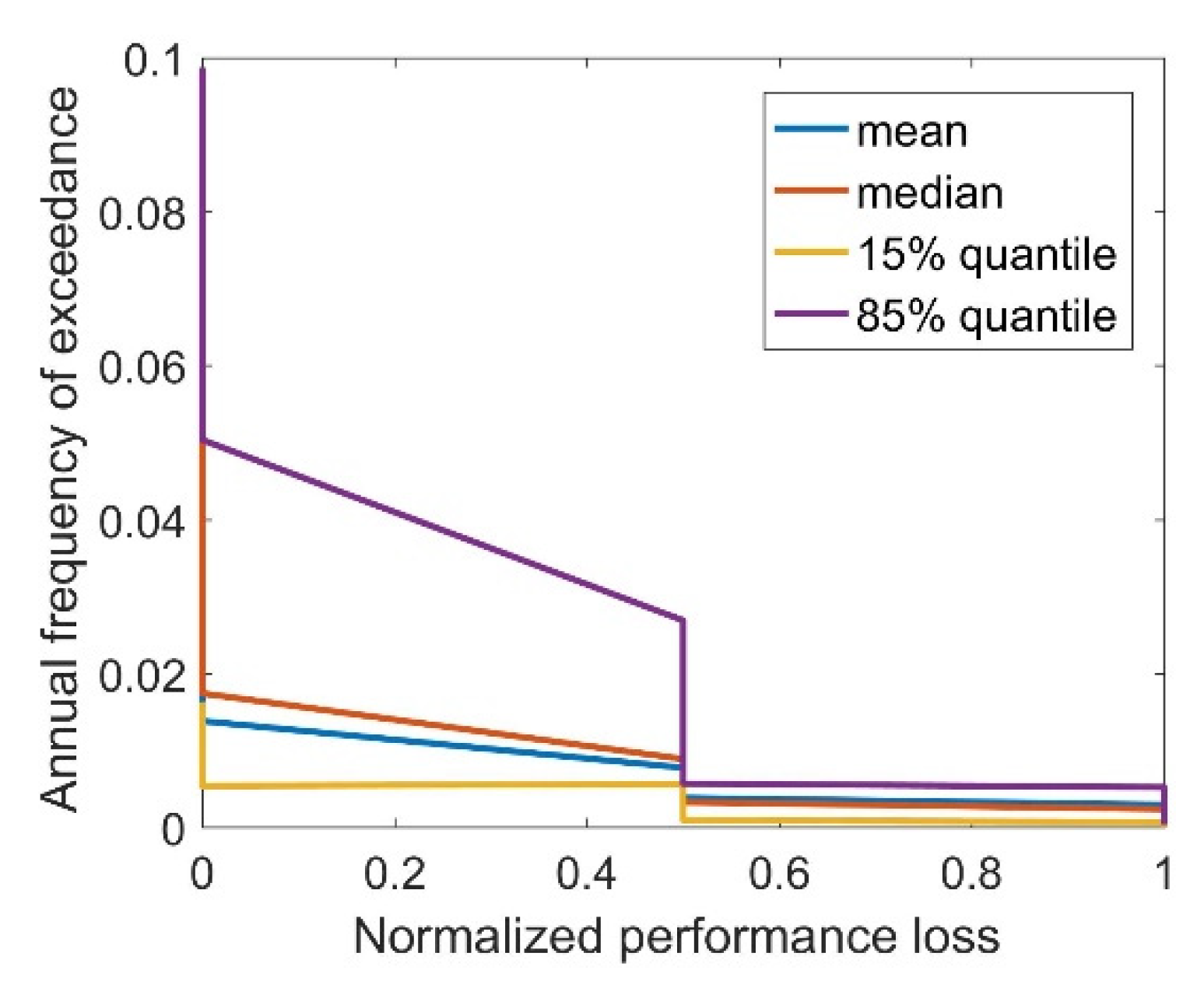
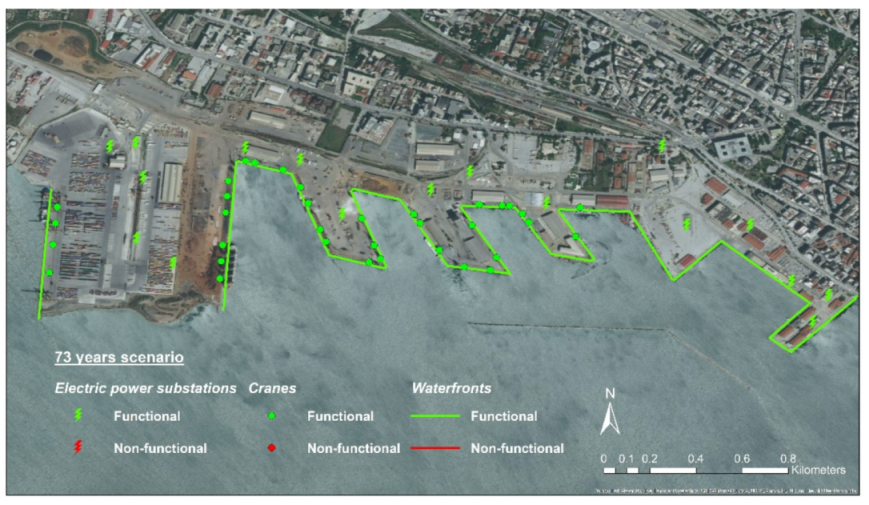
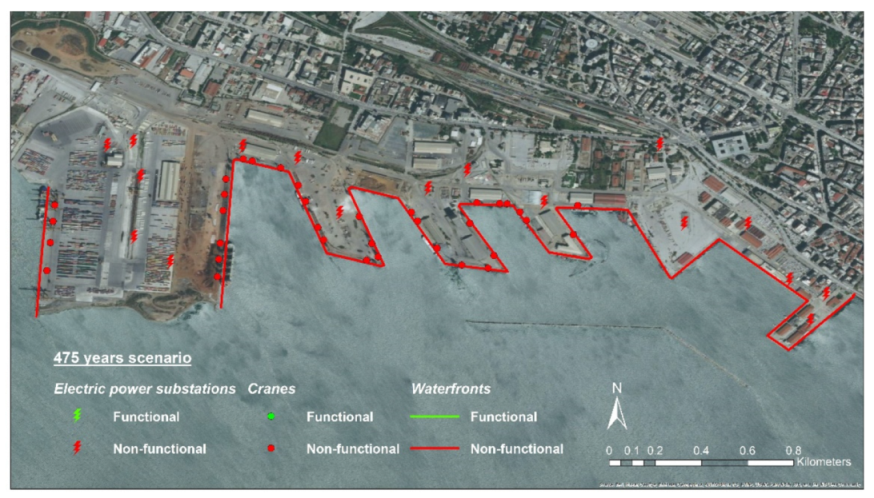
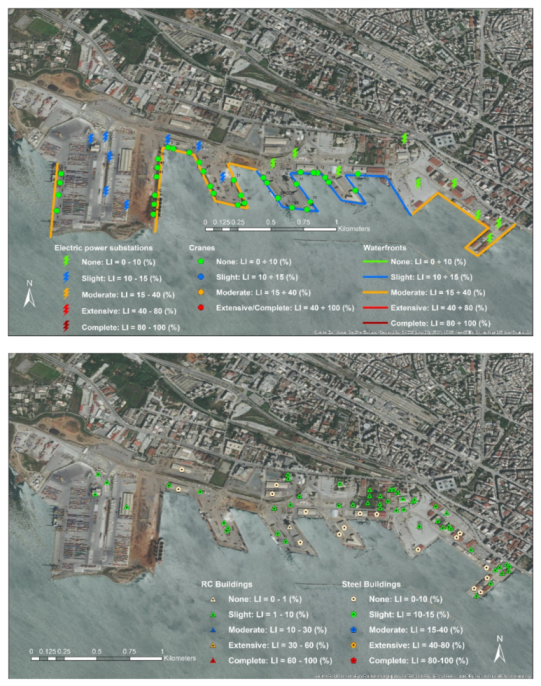
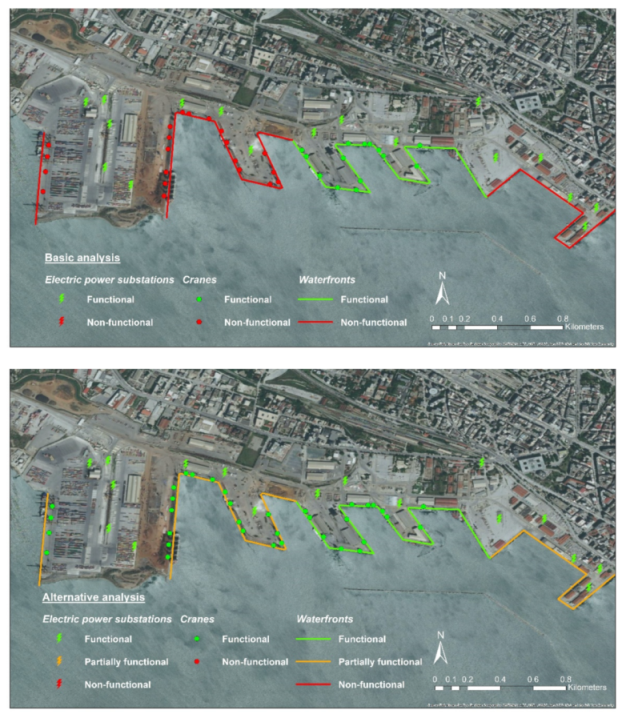
| Earthquake Name | Date | Mw | Fault Mechanism | Epicentral Distance [km] | PGA [m/s2] | EC8 Site Class | Waveform ID |
|---|---|---|---|---|---|---|---|
| Umbria Marche (aftershock) | 6 October1997 | 5.5 | normal | 5 | 1.838 | A | 651 |
| Valnerina | 19 September 1979 | 5.8 | normal | 5 | 1.510 | A | 242 |
| SE of Tirana | 9 January 1988 | 5.9 | reverse | 7 | 4.037 | A | 3802 |
| Lazio Abruzzo (aftershock) | 11 May 1984 | 5.5 | normal | 15 | 1.411 | A | 990 |
| Valnerina | 19 September1979 | 5.8 | normal | 5 | 2.012 | A | 242 |
| Kozani | 13 May 1995 | 6.5 | normal | 17 | 2.039 | A | 6115 |
| Friuli (aftershock) | 15 September1976 | 6 | reverse | 12 | 1.339 | A | 149 |
| Umbria Marche 1 | 26 September1997 | 5.7 | normal | 23 | 1.645 | A | 763 |
| Friuli (aftershock) | 15 September 1976 | 6 | reverse | 14 | 2.586 | B | 134 |
| Patras | 14 July 1993 | 5.6 | strike slip | 9 | 3.337 | B | 1932 |
| Kalamata | 13 September 1986 | 5.9 | normal | 11 | 2.670 | B | 414 |
| Umbria Marche 2 | 26 September 1997 | 6 | normal | 11 | 5.138 | B | 594 |
| Montenegro (aftershock) | 24 May 1979 | 6.2 | reverse | 17 | 1.708 | B | 229 |
| Kefallinia island | 23 January 1992 | 5.6 | reverse | 14 | 2.223 | B | 6040 |
| Ano Liosia | 7 September 1999 | 6 | normal | 14 | 2.159 | B | 1714 |
| Annual Collapse Probabilities | ||||
|---|---|---|---|---|
| Port Element | LS1 | LS2 | LS3 | LS4 |
| RC building/ Steel warehouse | 0.05 | 0.20 | 0.45 | 0.80 |
| Electric power substation | 0.08 | 0.275 | 0.60 | 0.90 |
| Quay wall/Crane | 0.08 | 0.275 | 0.70 | - |
| Annual Collapse Probabilities | ||||
|---|---|---|---|---|
| Port Element | Mean | Median | 15% Quantile | 85% Quantile |
| Gravity quay walls | 0.00405 | 0.00412 | 0.00121 | 0.00850 |
| Cranes | 0.00621 | 0.00657 | 0.00180 | 0.01291 |
| Electric power substations | 0.00066 | 0.00053 | 0.00013 | 0.00165 |
| Annual Collapse Probabilities | ||||
|---|---|---|---|---|
| Building Typology | Mean | Median | 15% Quantile | 85% Quantile |
| Low-rise RC frame | 0.00772 | 0.00823 | 0.00212 | 0.01432 |
| Mid-rise RC frame | 0.01485 | 0.01620 | 0.00387 | 0.02720 |
| High-rise RC frame | 0.00285 | 0.00285 | 0.00082 | 0.00596 |
| Steel warehouse | 5.17 × 10−07 | 4.08 × 10−07 | 3.06 × 10−08 | 4.2 × 10−06 |
| Normalized Performance Loss | ||||
|---|---|---|---|---|
| Basic Analysis | Alternative Analysis | |||
| TCaH | TCoH | TCaH | TCoH | |
| Median | 0.67 | 1.00 | 0.34 | 0.50 |
| Median + StDev | 1.00 | 1.00 | 0.50 | 0.50 |
| Median − StDev | 0.67 | 1.00 | 0.34 | 0.50 |
Publisher’s Note: MDPI stays neutral with regard to jurisdictional claims in published maps and institutional affiliations. |
© 2022 by the authors. Licensee MDPI, Basel, Switzerland. This article is an open access article distributed under the terms and conditions of the Creative Commons Attribution (CC BY) license (https://creativecommons.org/licenses/by/4.0/).
Share and Cite
Fotopoulou, S.; Karafagka, S.; Karatzetzou, A.; Pitilakis, K. System-Wide Seismic Risk Assessment of Port Facilities; Application to the Port of Thessaloniki, Greece. Sustainability 2022, 14, 1424. https://doi.org/10.3390/su14031424
Fotopoulou S, Karafagka S, Karatzetzou A, Pitilakis K. System-Wide Seismic Risk Assessment of Port Facilities; Application to the Port of Thessaloniki, Greece. Sustainability. 2022; 14(3):1424. https://doi.org/10.3390/su14031424
Chicago/Turabian StyleFotopoulou, Stavroula, Stella Karafagka, Anna Karatzetzou, and Kyriazis Pitilakis. 2022. "System-Wide Seismic Risk Assessment of Port Facilities; Application to the Port of Thessaloniki, Greece" Sustainability 14, no. 3: 1424. https://doi.org/10.3390/su14031424
APA StyleFotopoulou, S., Karafagka, S., Karatzetzou, A., & Pitilakis, K. (2022). System-Wide Seismic Risk Assessment of Port Facilities; Application to the Port of Thessaloniki, Greece. Sustainability, 14(3), 1424. https://doi.org/10.3390/su14031424






